Bike Washington’s
C&O Canal Bicycling Guide
Tires & Conditions
| Trip Planning | Mile-by-Mile | Trip Reports | Info-to-Go |
|
|
Bike Washington’sC&O Canal Bicycling Guide | Tires & Conditions |
|
What size tires should I use? Since the towpath is not paved, wider tires will help "smooth" out the bumps. 700x35 or 26x1.25 tires work just fine, but wider is better. Cross tires are a good choice for the trail. These tires typically have a smooth center tread for lower rolling resistance, but also have knobs along the side which help in muddy conditions.
However, with that said, I can tell you that I have seen every type of tire on the towpath. Last year, I ran into a guy that was fully loaded running on narrow touring tires. He was just completing a tour across the US, and was finishing up on the towpath. I have also seen guys with racing bikes on the path. So really, the question of tire size really comes down to rider comfort.
Also, a flat tire is a typical situation you may encounter along the trail, so be sure you can handle this minor inconvenience. Carry a patch kit and at least one spare tube. Some folks may even carry a spare tire.
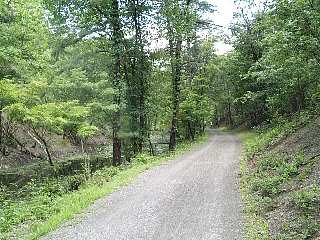
It is somewhat difficult to generalize the condition of the towpath. Basically, the path is composed of clay and crushed stone. However, some sections contain more clay than stone. Also, conditions change from month to month due to weather and maintenance. In general, expect conditions to be a bit rougher than your typical crushed limestone surface found on rail-trails.
This photo (left) from 2003 shows the best conditions you will find along the trail. Generally, expect best trail conditions between Mile 0 thru 20 and Mile 155 thru 184.
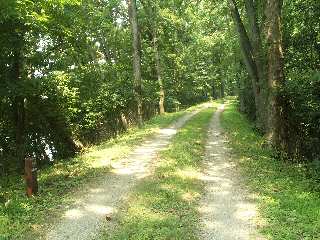 The photo on the right shows more typical conditions (Mile 91). Many sections are "dual-track"
with grass or loose debris filling the center between the two tracks. For this reason, I recommend
that you think twice about using a two wheel trailer to haul gear (although folks have successfully
used these trailers). Also, much of the old canal basin has been abandoned back to the forest,
so expect to spend most of the time riding trough the woods.
The photo on the right shows more typical conditions (Mile 91). Many sections are "dual-track"
with grass or loose debris filling the center between the two tracks. For this reason, I recommend
that you think twice about using a two wheel trailer to haul gear (although folks have successfully
used these trailers). Also, much of the old canal basin has been abandoned back to the forest,
so expect to spend most of the time riding trough the woods.
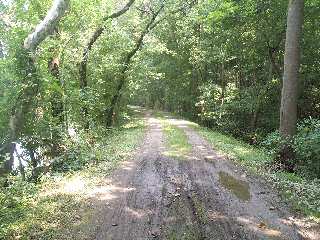 Expect to see lots of these "typical" mud holes. The number of holes you encounter
will depend on how much rain the area has received prior to your trip. Often, you can easily
navigate around these types of holes simply by hoping over to the other track
or riding down the middle.
Expect to see lots of these "typical" mud holes. The number of holes you encounter
will depend on how much rain the area has received prior to your trip. Often, you can easily
navigate around these types of holes simply by hoping over to the other track
or riding down the middle.
Typically, expect to see the muddiest conditions between Mile 25 thru 30 and Mile 124 thru 134.
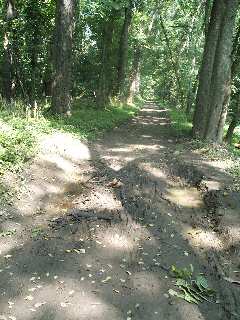 The next photo shows a "monster" mud hole somewhere around mile 28. This was probably
one of the largest holes I found during the 2004 ride, but no where near as bad as some of holes
encountered in 2003. These are very difficult to navigate around, especially if you are top heavy
with 40 lbs of camping gear!. Often, it is safer to just ride through these guys instead of trying
to go around on the narrow, slippery edges.
The next photo shows a "monster" mud hole somewhere around mile 28. This was probably
one of the largest holes I found during the 2004 ride, but no where near as bad as some of holes
encountered in 2003. These are very difficult to navigate around, especially if you are top heavy
with 40 lbs of camping gear!. Often, it is safer to just ride through these guys instead of trying
to go around on the narrow, slippery edges.
This hole was most likely filled later that afternoon by a maintenance crew. Apparently, the "honey wagon" (restroom service truck) got stuck in one of these holes the day before and had to be pulled out.
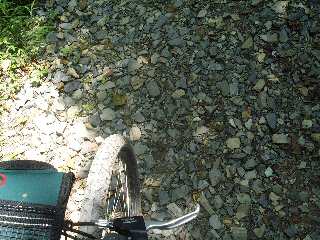 In 2004, the section between Mile 37 and 40 had been nicknamed the "Big Gravel Area".
A year early, this section was nearly impassable due to some of the largest mud holes I had
ever seen on the towpath. The park service eventually closed this section for a few weeks
after Hurricane Isabel came through. It appears this was the only fill material they had
available at the time.
In 2004, the section between Mile 37 and 40 had been nicknamed the "Big Gravel Area".
A year early, this section was nearly impassable due to some of the largest mud holes I had
ever seen on the towpath. The park service eventually closed this section for a few weeks
after Hurricane Isabel came through. It appears this was the only fill material they had
available at the time.
I had no problem with this section, thanks to my 1.5" tires and front suspension. However, skinny tire folks did have a bit of a rough ride here.
Anyway, this section has since been resurfaced. However, this does show that conditions can change at any time, so you should be prepared for pretty much anything.